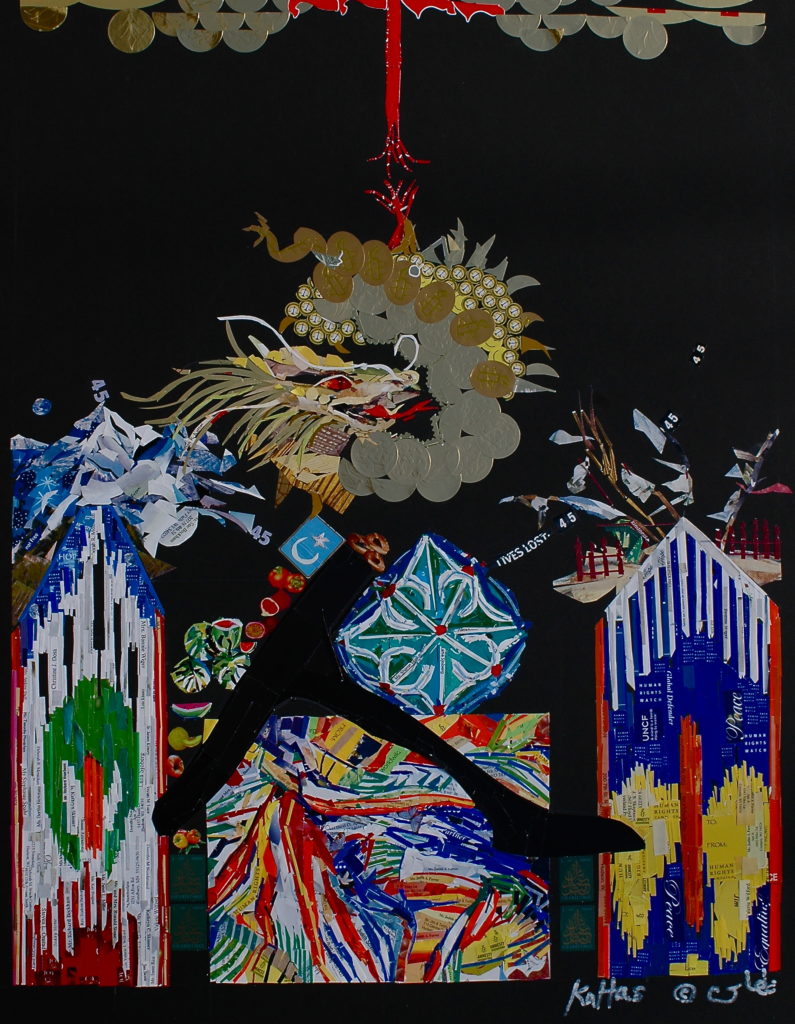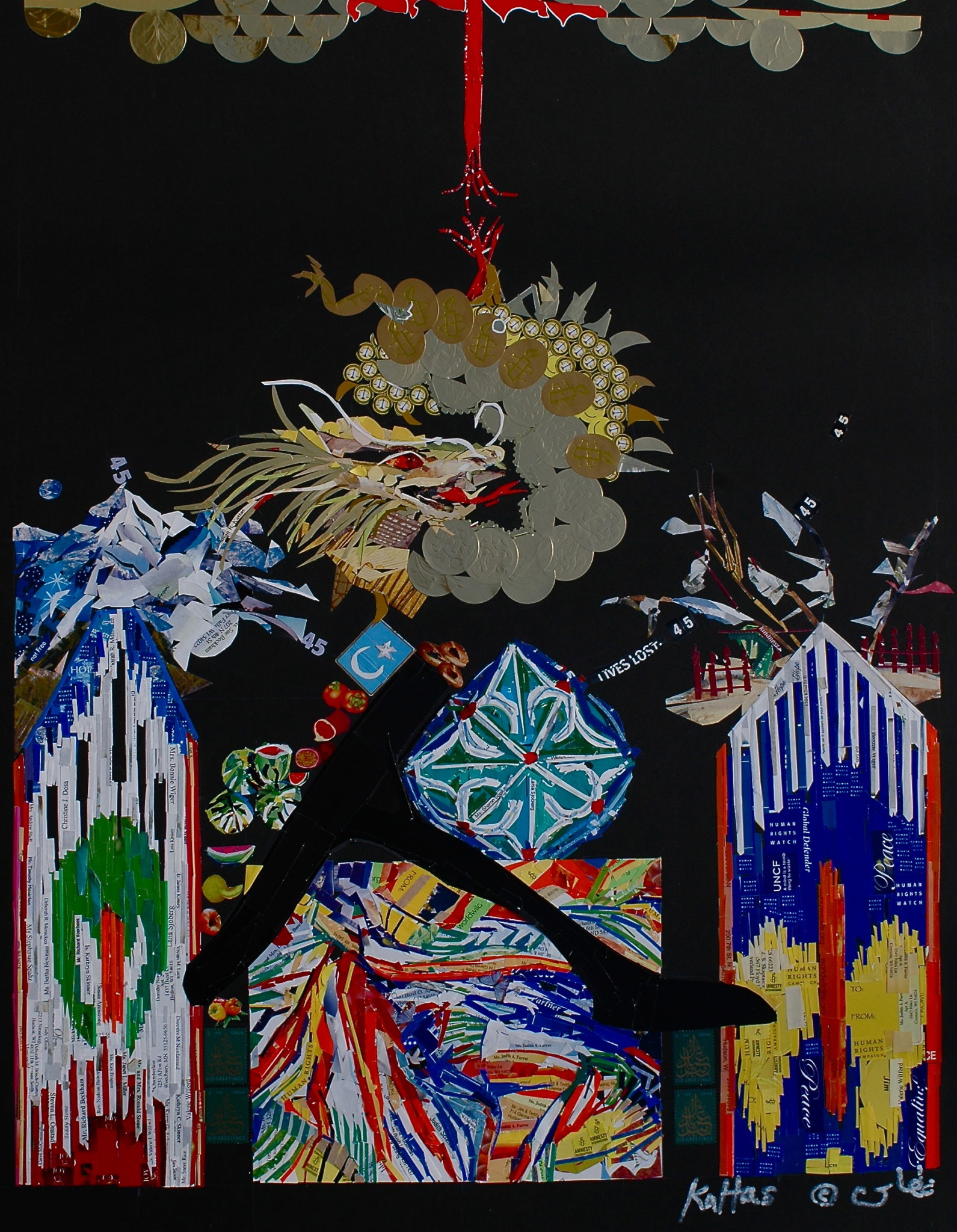We Are Uyghur: Artist Q&A with Susan Kattas

January 21, 2014
Greg Fay, Manager, Uyghur Human Rights Project
Susan Kattas, a Hudson, Wisconsin-based artist, recently created a collage inspired by the Uyghurs’ cultural struggle under Chinese government repression. The collage was part of the 45th Parallel Exhibition celebrating peoples living along the 45th parallel, the line of latitude that extends from Hudson to Urumqi, capital of the Uyghur homeland of East Turkestan, and shows at the Phipps Gallery through February 9, 2014. Kattas described the piece to UHRP:
GF: How have you depicted Uyghur culture in your work?
SK: We Are Uyghur is a collage of cultural handcrafts and traditional icons of this ethnic minority people living on the 45th Parallel. Currently the Uyghur people are experiencing documented patterns of abuse and deliberate campaigns to suppress their identity, traditions, and beliefs.
For this collage, repurposed address labels and decal stickers are used to realistically depict the following: colorful Uyghur atlas textiles viewed in the lower section of the collage; the Tengri Tagh mountains near the capital; simple flags attached to poplar wood sticks honoring a mazar or Uyghur religious shrine; fruit; bread; the national flag of East Turkestan; and the doppa, a traditional four pointed embroidered hat. I favored a design of doppa more like ones worn near Urumqi because it is located near the 45th Parallel.
The golden dragon symbolizes a powerful China imposing itself as it appears to crush Uyghur society. I hope it conveys China’s crushing impact on the cultural and religious traditions of the Uyghur people. The Mandarin calligraphic symbol for “human,” 人, is nestled as negative space from within the illustrated Uyghur crafts and icons covertly asserting Uyghur “humanity,” even as their culture is destroyed.
GF: Why did you use repurposed materials to create the collage?
SK: “Repurposed” materials are finding their way into all forms of art today as a current directions for some artists with it’s history starting with Picasso’s collages made from “found materials.” Repurposed implies that the individual address labels with color and slogans are transformed into use as color, texture and creating the contrast that makes objects look real and three-dimensional.
As I select batches of address label stickers suitable for their color, others are set aside for their text and symbolic icons. In this work I set aside the text saying “Human Rights Watch,” “worldwide,” “lives lost,” and “not free.” Another organization’s logo used is Amnesty International, appearing with a justice symbol as the dragon scales. The implication is that I am calling for cessation to Chinese systematic campaigns to suppress the Uyghur.
GF: How did your own background and family history impact this artwork?
SK: I have taken two graduate level art history classes in Islamic art with one of them focused on Persian art so I feel some comfort finding my way looking at Islamic art and architecture and this offered a modicum of help in my research and image selection. Other selections were purely just artistic choices for the composition to work for me visually. I have produced one specifically Islamic art piece as a painter titled Tugra, which can also be seen on my website (here). A tugra is the very fancy calligraphic signature in Arabic of a Turkish sultan. I was inspired to do this piece following my two University of Minnesota Islamic art history classes with Dr. Catherine Asher. My piece is an interpretation of a tugra.
I also signed my name on the art piece in Arabic, as well as English. My grandfather (my Giddo) immigrated to America from Lebanon and I used his signature as a guide. My grandparents on my father’s side were Christian Arabs from Rashaya el Wadi who immigrated around 1900 through Ellis Island. They lived near other Lebanese people in Fort Wayne, Indiana. My grandparents’ children including my father were born in the United States.
GF: How did you become interested in the Uyghur people’s cultural struggle?
SK: I first read about the Uyghur people in National Geographic and heard about the abuse of the people in the news. I became aware of these types of actions to non-Han people when I visited Tibet in 2010, another “autonomous region” of China.
As I addressed the theme for this special 45th Parallel Exhibition, I traced the globe, first considering a location in Italy but then remembered hearing about the Uyghur and with my experiences in Tibet, my selection was cemented. I looked at hundreds of photos and read many articles about Uyghur history. I focused on the present and selected ideas and images that were taken from the cultural arts first, then daily life, the environment, and concluding with the mazar as an expression of the Muslim religion. My studies at the U of M covered shrines, cenotaphs, burial customs, etc. I found interviews with artist Lisa Ross fascinating and created a composite of the myriad of images I viewed online by many photographers. I created preliminary drawings for the mountains, dragon, a mazar, watermelons, and doppa before starting the collage.
GF: What do you hope to achieve with this collage?
SK: I hope to achieve with this piece an awareness of the Uyghur people and their threatened situation. I observed first hand during my visit in Lhasa, Tibet the dismissive attitude the Chinese government obviously has for these gentle people. For example storefront signs had been changed to Mandarin first then Tibetan. Soldiers marched right through a crowd of people in step with eyes forward. While a quiet tone of respect was expected in the Tibetan museum, Chinese guides belted out their words during a tour. Our local guide said the Chinese want their children to learn Mandarin and eliminate their language As for the suppression of religious freedom, we all know the history of the Dalai Lama.
For more on Susan Kattas and to purchase the piece, please visit her website: http://www.susankattas.com/

